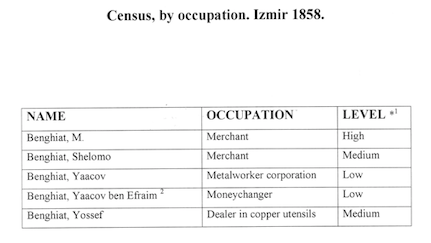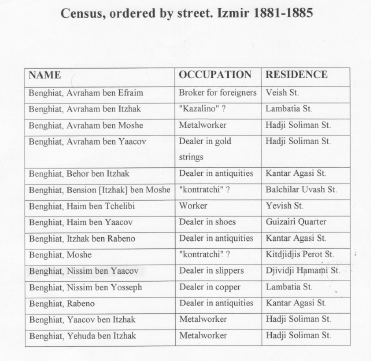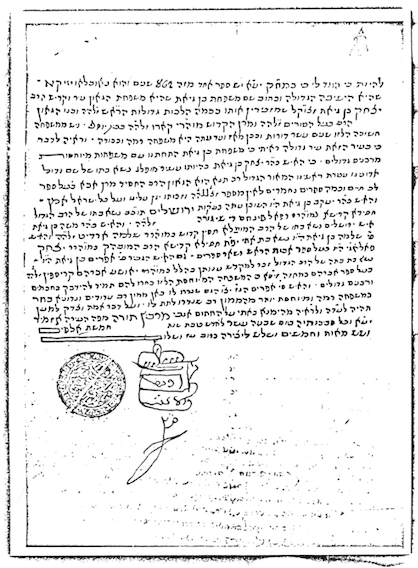|
Expulsion From Spain To Izmir Turkey
According to family lore, the ibn Giat family lived in Cairo for “40 years” after the expulsion from Spain. Part of the family immigrated to Turkey and changed the Arabic ibn Giat to the Hebrew ben Ghiat. They probably arrived in Smyrna, as it was known in the 16th century along with many descendants of Spanish exiles from Salonika, Rhodes, Constantinople and neighboring towns. Abraam Bengiat in Solinica, Greece 1500s “Nevertheless, even in this initial phase [16th century], the Jews of Thessaloniki played a leading role. Abraam Alfanderi, Isach Ergas, Moise Botton, Samariam Amies, Moise Mathalon, Isach Charalvo, Josef Caldenon, Moise Ergas, Caim Lindo, Josef Marac, Moise Magli, Salamon Oef, Daniel Benbelech, Abraam Bengiat, Daniel Membrech , Salamon Calfou, Franca Navarra and Dona Bonadona Parda (as two female participants in this circle of business people), Emanuel Fresco, David de Passi, Josef Baruch and Samuel Baruch dominate this initial phase in great style.12 They form a fairly numerous aristocracy, among Balkan merchants, both Christians and Jews, and slowly but persistently create those trade and business connections that were necessary for the developing system to be included in the international division of labor, to overcome and to a large extent sign from the interior of the Balkans all other trade concurrency, in order to seriously threaten the already consolidated positions of the Dubrovnik merchants themselves, and to eliminate all others, to a greater or lesser extent, in that part of the Balkans that stretched from Constantinople in the east to Lješ and Valona in the west and, in the initial phase, from Skopje to Thessaloniki.13” Prof. dr Zdenko ZLATAR, “TRADE OF BALKAN JEWS VIA DUBROVNIK IN THE 16TH AND 17TH CENTURIES (ANALYSIS OF THE I*ZVOZ SYSTEM)” Benghiat Family Documented in Smyrna in 1675 Our earliest Izmir records are of Y. Benghiat (1675) and A. Benghiat (1690). Several Benghiat names were recorded as members of the “Hebra Kadisha” in Izmir in 1780 including: Yehiel Ephraim (b.1700, d. 1784 in Jerusalem), Haim ben Yoseph, Yaacov, Moshe, Abraham, Itzhak, Haiym Itzhak, Yaacov, and Haiym Abraham. "Among the benefactors of the Jewish community of Smyrna may be mentioned: Alexander Sidi, who purchased the cemetery of Burnabat in 1881; Moses b. Ghayyat; Ḥayyim Argi and his wife; Jacob Melamed; Nissim Levy; Abraham Pardo; the Baron and Baroness de Hirsch; and Baron Edmond de Rothschild." Jewish Encyclopedia: 1906, Vol 11 P:416. A letter written by the Chief Rabbi of Izmir, Abraham Palatche (1809-1899) to Chief Rabbi Adler of London on January 5th, 1893, addresses the pedigree of the Benghiats of Izmir. [Quoted below and translated by Dov Cohen. Dates and comments in brackets are added by Dov Cohen and not in the original letter.] “I have heard that in the library of your Yeshiva there is a book dated from 862 years ago, and is mentioned there the surname Benghiat. This is the family of the Rabbi Itzhak Benghiat, referred many times in the rabbinical literature of the Rabbi Acher Ben Yehiel, his son Rabbi Yaacov Ben Acher and also Rabbi Yossef Caro. There are 11 generations from this family, and she is a very noble and eminent family. Proof of that is the fact that in our city Izmir, I have seen that the Benghiat family always were related to gentlefolk families of known rabbis: The man Itzhak Benghiat, albeit he was a very rich man, married the daughter of Rabbi Haim Palatche [1788-1868, writer’s father]. The man Yaacov Benghiat, living now in Jerusalem, married the daughter of Rabbi Pinchas de Segura [died 1851]. The man Moshe Benghiat from Jerusalem, married the daughter of the Rabbi Shlomo Eskenazi. The man Shlomo Benghiat [died 1907] married the daughter of Rabbi Itzhak Palatche [1814-1907, writer’s brother] The man Efraim Benghiat, married the grandchild of Rabbi Yeoshua Avraham Crespin [died 1855]. This man Efraim Benghiat, albeit received offers of big dowries, preferred to marry a spouse descendant from a noble family. Being all of the above true, I sign here my name, 17th Tevet 5653, Rabbi Avraham Palatche, Chief-rabbi of Izmir” (The header photo at the top of the page shows Jewish community members of Izmir with Chief Rabbi Abraham Palatche (front center) in 1896.) Izmir Census of 1838 and 1881 The census in Izmir,1838 lists five Benghiat men, their occupations and income level. The census in Izmir 1881-1885, lists 15 Benghiat men, their occupations, and the streets on which they lived. My great-grandfather is Nissim ben Yaacov Benghiat, Dealer in slippers. [See left column.] Twenty-eight separate branches of the Benghiat family tree have been uncovered in Izmir though research conducted by Dov Cohen of Israel in 1997. Today, one Benghiat and one Bengiyat branch of the family live in Izmir. Several connections of the Benghiat family tree branches have been established, but many remain separate. Yitzchak Benghiat of Izmir, My Great-Great-Great Grandfather Yitzchak had at least one son, Jacob, born about 1800, who had three sons and a daughter. Jacob's son, probably Isaac, immigrated to Cairo and played the violin (as told by my grandfather’s brother Jacob to his daughter Suzie Benguiat Taranto). Jacob's son, Abraham, was a wealthy dealer of antiquities including rare oriental rugs. He changed the spelling of his name to “Benguiat” so it had a hard “g” sound in French. (See below Abraham Benguiat and His Five Sons.) Jacob's son, Mordecai Nissim, owner of a shoe factory, was my great grandfather (See Benghiat World webpage, Great Grandparents Mordecai [Nissim] Benghiat & Celia Abrams). Jacob’s daughter, Sarah. married Raphael Capouya/Kapoya, who was a twin. Their daughter Rose Kapoya married Avram Levy. Their daughter, Sultana Levy married my grandfather, Joseph Benghiat, son of Nissim. Abraham Benguiat and His Five Sons Born in Izmir, moved to Alexandria, and died in Jerusalem, Abraham Benguiat was a very rich and powerful merchant. His great-granddaughter Anita Bohbot, in her memoir, Rebel, states “people called [him] ‘El Papau de las liras,’ the father of money in the Ladino language.” Jacob Benguiat, brother of my grandfather Joseph Benghiat, remembered him as the “rich uncle who moved to Egypt." Abraham married Rachelle De Vidas (1835-1880). All five sons became expert dealers in art and antiquities, especially Oriental rugs, ancient tapestries and textiles. Although the five Benguiat sons and their descendents spell their name with a “u”, a photograph from the Benguiat Family Archives in the Jewish Museum of New York (see above left column.) shows the family at her stone setting in Izmir with the tombstone inscribed “Rachelle Benghiat” with an “h” rather than "u".. Hadji Ephraim, (1852-1926), the eldest brother was born in Izmir, settled in Boston in 1888, San Francisco and finally Edgewater, New Jersey. King Edward VII of England was one of his clients. He occupied an office/showroom in the building of the San Francisco Examiner and later near the Empire State Building in NYC. He was a prominent member of Congregation Shearith Israel, the Spanish and Portuguese Synagogue of New York, which was the first Synagogue in North America, founded in 1654. Hadji’s great grandson Edward Benguiat, is a renowned designer of typefaces, including one font he named “Benguiat”. Second son David Benguiat (1866-1951) was born in Alexandria. He established himself in London in 1878 as one of the greatest experts on textiles. From that time on he had been consulted by the leading museums of England and the continent. Vital Benguiat (1861-1939) was born in Alexandria, came to the United States from Egypt in 1890 to assist Stanford White in making selections for the J. Pierpont Morgan, William C. Whitney and other important private collections. Queen Elizabeth was one of his distinguished clients. He sold a pearl necklace that had belonged to Catherine II of Russia to Cartier, Inc. inn1920. Cartier resold it to Horace E. Dodge for $825000. Vital’s obituary and photo were printed in The New York Times. Leopold Benguiat 1863-1953) may have been born in Alexandria or Izmir. His granddaughter Anita Bohbot in her memoir, Rebel, relates, “Grandpa Leopold was born in Izmir, Turkey … Leopold was the fourth of five brothers. When he was a little boy, the family had moved to Alexandria in Egypt, where he grew up in the middle of splendor…”. Leopold and Vital purchased The Davanzati Palace in Florence with its entire contents in 1924 or 1925 and owned it until 1934. The palace contained many fine examples of Italian Renaissance art. The building now houses the Museum of the Antique Florentine Home. Leopold married Njma Osiel and later lived in Paris, Nice (former Palace of the Duke of Savoy) and Tangier where he built the Benguiat Palace in the Moorish style in 1930. Leopold died in Paris and is buried in Casablanca. Benjamin Benguiat (1872-1956) was born in Alecandria, came to New York from London in 1898 as an advisor to architect Stanford White in his purchase of art objects for collectors, replacing his brother Vital. Benjamin sold to J. Pierpont Morgan a rare Gothic tapestry called “Seven Sacraments,” which now hangs in the Morgan Wing of the Metropolitan Museum of Art in NYC. Benjamin also assembled the Senator William A. Clark collections of rugs on display in the Corcoran Galleries in Washington, D.C. During the twenties, Benjamin moved to Los Angeles where he continued his art dealings. On his return to New York, he established a manufacturing and jobbing business for men’s formal wear accessories called Mason des Fleurs. His obituary also appeared in The New York Times. . The Benguiat family collection of Sephardic objects was exhibited at the Chicago World’s Fair in 1893. From there, the collection went to the Smithsonian Institution in Washington, D.C. in 1901. Today, the Benguiat Collection is an original component of the permanent holdings of the Jewish Museum in New York City. The collection contains a large number of Sephardic works, including several personal family artifacts and photographs of the Benguiats. "Several objects on view were of particular personal significance to the Benguiat family, providing insights into the family’s history. Many originated in the Ottoman Empire and refer directly to the family’s Sephardic heritage. A velvet Torah mantle from Istanbul (ca. 1881) is dedicated in memory of Rachel Benguiat, Hadji Ephraim Benguiat’s mother" [See bottom image left column.] An amulet, written when Hadji was sick as a child, offers a prayer to protect him from the “evil eye,” and contains a hexagram, a magic box, and invocations of names of angels, all of which were believed to have mystical healing powers. Also on view are an Italian Majolica Passover Seder plate and an ornately decorated copper handwashing vessel and laver used by the family for Passover." https://www.mannpublications.com/mannreportresidential/2019/08/20/masterpieces-and-curiosities-the-benguiat-collection/ Stories about the five Benguiat brothers abound in Wesley Tower's, The Elegant Auctioneers, INew York: Hill & Wang, 1970. “There were, in all, five Benguiat brothers, all carpet sellers, all bearded and omniscient. Smyrna had cradled them. Alexandria had conditioned them. According to Ephraim, the eldest and most lugubriously hirsute of the brothers, the family origins went back to Spain in the eleventh century, if not directly to the pages of Genesis and Exodus. Spanish Hebrew was their language, the ritual of a dream-like Sephardic isolation, the only formal education any of them ever had. One by one they had come out of the Levant—Ephraim first, then David, Vital, Leopold, and Benjamin—to seek their fortunes, first in London, then throughout the Western world. In later times Vital said that he had supported the whole family since the age of twelve—a libel hotly contested in the internecine lawsuits that preoccupied the Benguiats through their middle years.” Hadji Ephraim's great-grandson, Ephraim "Ed" Benguiat was a celebrated graphic designer known for creating more than 600 typefaces including "Benguiat" and corporate logos inluding Ford and AT&T. His obituary appeared in The New York Times on Oct. 6, 2020, https://www.nytimes.com/2020/10/16/business/media/ed-benguiat-dead.html Yaacov and Yehuda Bengiyat of Izmir The 1881-1885 census lists Yaacov ben Itzhak and Yehuda ben Itzhak, metalworkers, living on Hadji Soliman Street. They were brothers and ancestors of the Bengiyat family who lived in Izmir. According to the census, they lived around the corner from Nissim ben Yaacov Benghiat, dealer in slippers, on Djividji Hamami Street. Leon Bengiyat, the patriarch of the Bengiyat family in Izmir, told me when I visited Izmir, that because of their proximity, Yaacov and Yehuda must have been closely related to Nissim, probably cousins. Nissim is my great-grandfather. Therefore, the Bengiyat branch and my Benghiat branch are related. Journalists Alexandre and Moses Benghiat of Izmir, Cairo and Buenos Ares Europe, and particularly France, opened up to Sephardic Jews in the late nineteenth century, which led to an explosion of journalistic and literary activity. La Verdad (The Truth) was a French language newspaper published in Izmir that covered the Ottoman Jewish community. Edited by Alexander Behor (the Eldest) Benghiat, David Ben Ezra and Rafael Kori, La Verdad appeared in 1884 and continued for several years. Later, El Meseret (Joy) published by Alexander Benghiat and his brother Moses, became an important newspaper from 1897 to 1908. Articles appeared in Ladino and Turkish trying to teach Turkish to the Jewish community and teaching Turks about Jewish life and customs. After 1891, it published only in Ladino and so limited its message entirely to its Jewish readers. A prolific author, Alexander also published dozens of novella. However, he died a pauper. The Jewish Community Board of Izmir voted to provide a tombstone for Alexandre Benghiat, without fee, on November 11, 1925. Alexandre’s brother Moses settled in Egypt and published the Ladino newspaper, La Luz (the Light) on a weekly basis starting in 1907. Moses emigrated to Buenos Aires, Argentina with his wife and children. Moses corresponded with the Chief Rabbi of Izmir on April 24, 1934 seeking information on his brother Alexandre. Moses’ descendents live in Buenos Ares and Chile. Descendents of Moses remain in Argentina Alexandre's second wife Graziella Benghiat, was one of the very first fully qualified female dentists in the world. She came from Smyrne and was also the editor of "Les Annalles in Izmir" magazine in 1914. Alexandre's great-grandson told me that Graziella and her son Alexis (Sandro) fled the great Smyrne fire of September, 1922 for Paris, where he changed his name to Vengiatis and lived as a Christian until his deathbed confession to his son that he was born a Jew. The Spanish academic, Amelia Barquin Lopez has published her PhD thesis (1995) and at least two articles on Alexander. Un periodico sefardi: El Meseret de Alexander Ben-Guiat, SEFARD, Madrid, 1997 and Le Langua De Las Novelas De Alexander Ben-Guiat, Hispano-Jewish Civilization After 1492, Jerusalem, 1997. Abraham Benghiat of Izmir and Cairo Abraham (Behor) Benghiat was an Izmir merchant specializing in tapestries, rugs and antiquities. Abraham moved his antiquities business to Cairo where he had a store near the Shepherd’s Hotel. Abraham had five children: Robert, Isaac, Violet, Matilde and Salvatore. Robert, the eldest son, continued working in the store. Isaac headed the Arrow Shirt company in the Belgian Congo and later disappeared in Africa’s Azure Coast. Violet moved to New York. Matilde lived in France. The much younger Salvatore moved to Italy and then to Egypt in 1935. Sources About Jewish Smyrne https://www.bh.org.il/the-jewish-community-of-izmir/ http://www.jewishvirtuallibrary.org/izmir-turkey-jewish-history-tour http://www.jewishencyclopedia.com/articles/13813-smyrna https://turkeytravelplanner.com/special/jewish/JewishIzmir.html |




